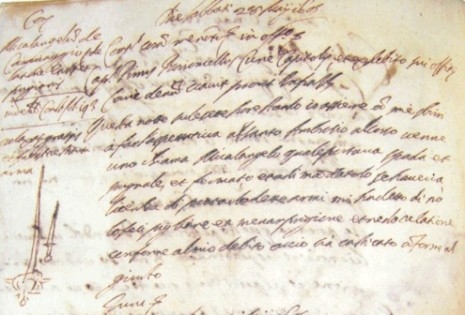
He was the bad boy artist whose life inspired film-makers and writers to cast him as a sexual revolutionary or a proto-anarchist of the Renaissance, but the release of his police files suggest the genius painter Caravaggio was more of a gang member with a list of petty crimes and one murder to his name.
An exhibition of documents, at Rome’s State Archives, details Michelangelo Merisi da Caravaggio’s numerous run-ins with the police, all of which are described in “handwritten police logs, legal and court parchments,” the BBC reports:
The picture the documents paint is that of an irascible man who went about town carrying personal weapons - a sword and dagger, and even a pistol - without a written permit, boasting that he enjoyed the protection of the ecclesiastical authorities who commissioned some of his most famous works.
He had frequent brushes with the police, got into trouble for throwing a plate of cooked artichokes in the face of a waiter in a tavern, and made a hole in the ceiling of his rented studio, so that his huge paintings would fit inside. His landlady sued, so he and a friend pelted her window with stones.
All these events are documented with eyewitness accounts in this collection of yellowing parchments - difficult to decipher for the non-specialist, but rich in contemporary detail for a skilled archivist.
The documents provide a completely new account of his most serious brawl in May 1606 in which he killed a certain Ranuccio Tommassoni. This brawl - just like a modern-day clash between warring gangs - was arranged in advance by eight participants who have all now been named.
Caravaggio and his three companions, one a Captain in the Papal army, met their rivals at a pallacorda court in the Campo Marzio area, where the artist lived. (Pallacorda was a game played with a ball with a string attached - an early form of tennis, which some older Romans still remember seeing played in the streets of the capital in the mid-20th Century.)
Some biographers have suggested that there may have been an argument over a woman, but the text of the court report suggests the quarrel broke out over a gambling debt. Caravaggio killed Ranuccio and fled the city.
One of Caravaggio’s own supporters was seriously injured. Taken to prison, he was subsequently put on trial, and the new evidence emerges from the report of this trial.
Caravaggio himself fled south to Malta and to Sicily where he received important new art commissions. The death sentence from Pope Paul V - whose portrait he had just painted - was imposed in absentia for this offence.
About 17 o’clock [lunchtime] the accused, together with two other people, was eating in the Moor’s restaurant at La Maddalena, where I work as a waiter. I brought them eight cooked artichokes, four cooked in butter and four fried in oil. The accused asked me which were cooked in butter and which fried in oil, and I told him to smell them, which would easily enable him to tell the difference.
He got angry and without saying anything more, grabbed an earthenware dish and hit me on the cheek at the level of my moustache, injuring me slightly… and then he got up and grabbed his friend’s sword which was lying on the table, intending perhaps to strike me with it, but I got up and came here to the police station to make a formal complaint…
The documents also shed light upon Caravaggio’s death at Porto Erole, north of Rome in July 1610. He did not die alone on a beach after escaping from his creditors and the police, as some of his biographers say, but in a hospital bed.
Only 38 years old, he was on his way back to the city from the south in the belief that his powerful friends had secured a pardon for his offences.
The documents that record Caravaggio’s life in Rome are written in a mixture of Latin legal jargon and racy Italian vernacular that any modern Roman could easily understand.
They needed careful restoration, as parts of the parchment were breaking up - the acid in the ink literally devouring the pages.
Detail of case against Michelangelo De Caravaggio charged with illegal possession of a sword and a dagger.

In 2006, Simon Schama’s Power of Art examined Caravaggio‘s life and work through his painting David with the Head of Goliath, as it explained how:
The power of the greatest art is the power to shake us into revelation and rip us from our default mode of seeing. After an encounter with that force, we don’t look at a face, a colour, a sky, a body, in quite the same way again. We get fitted with new sight: in-sight. Visions of beauty or a rush of intense pleasure are part of that process, but so too may be shock, pain, desire, pity, even revulsion. That kind of art seems to have rewired our senses. We apprehend the world differently.
Historian Schama wrote of the great painter:
“In Caravaggio’s time it was believed that artists were given their talent by God to bring beauty to the world and to put mortal creatures in touch with their higher selves or souls. Caravaggio never did anything the way it was supposed to be done.
In this painting of the victory of virtue over evil it’s supposed to be David who is the centre of attention, but have you ever seen a less jubilant victory? On his sword is inscribed “Humilitus Occideit Superbium”, that is, humility conquers pride. This is the battle that has been fought out inside Caravaggio’s head between the two sides of the painter that are portrayed here.
For me the power of Caravaggio’s art is the power of truth, not least about ourselves. If we are ever to hope for redemption we have to begin with the recognition that in all of us the Goliath competes with the David.”